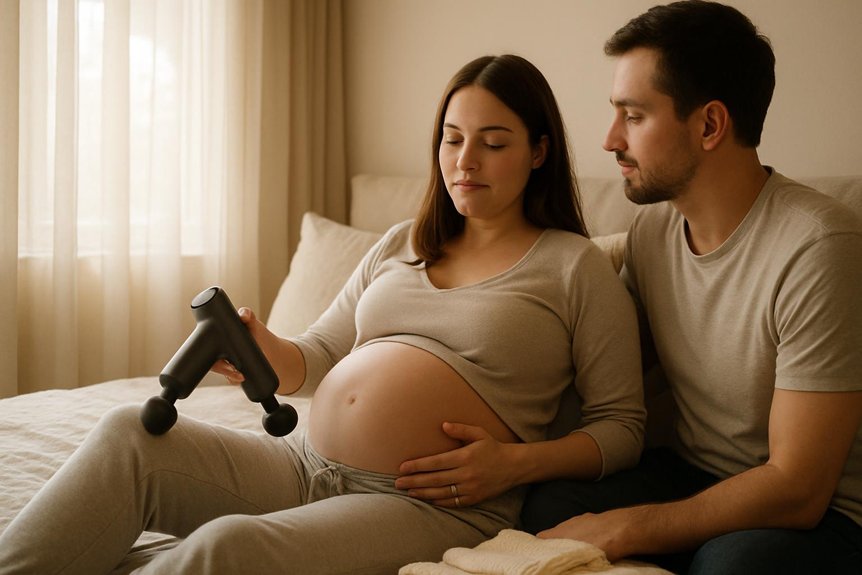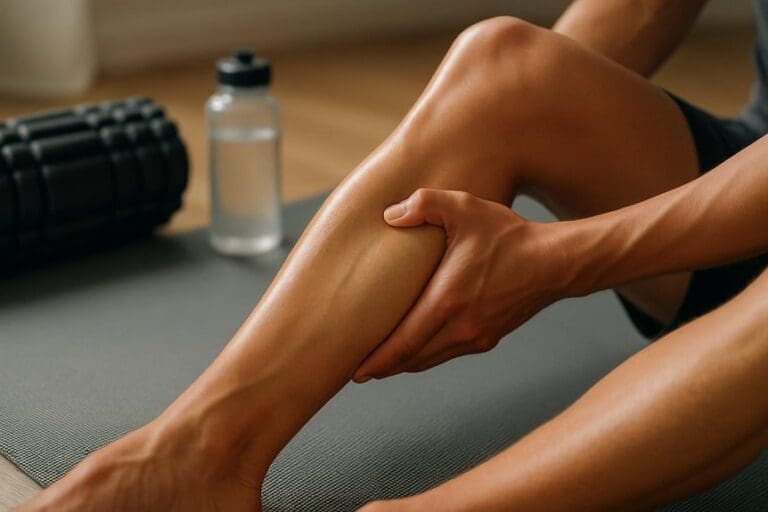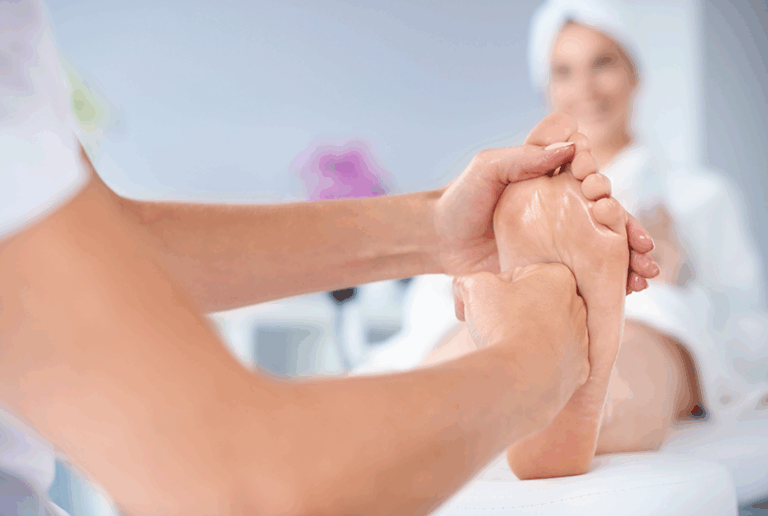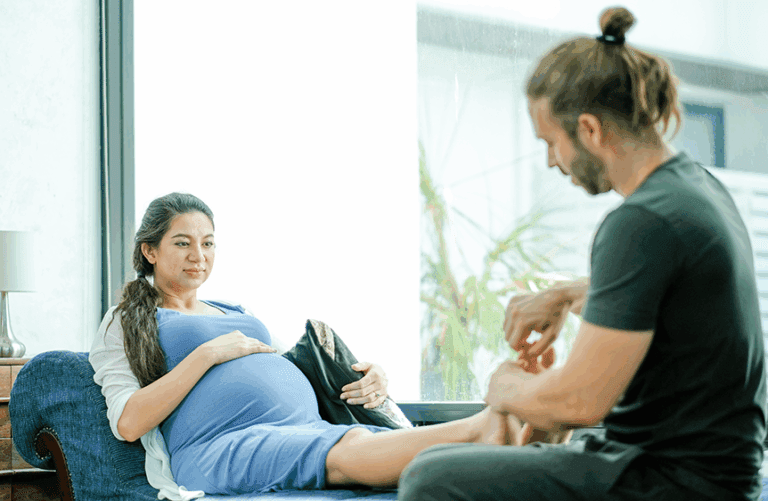A massage gun may be used in pregnancy only with caution. Evidence is limited; high-frequency percussion can irritate tissue and provoke discomfort. Avoid the abdomen, lower back/sacrum, pelvis, and inner thighs. Use the lowest setting, broad head, and brief applications (30–60 seconds per muscle; total under 10 minutes) on peripheral areas like calves, forearms, or upper back. Stop if pain, numbness, dizziness, cramping, or fetal movement changes occur. Seek medical clearance, especially in first or late trimesters; safer options are outlined ahead.
Is a Massage Gun Safe in Pregnancy?
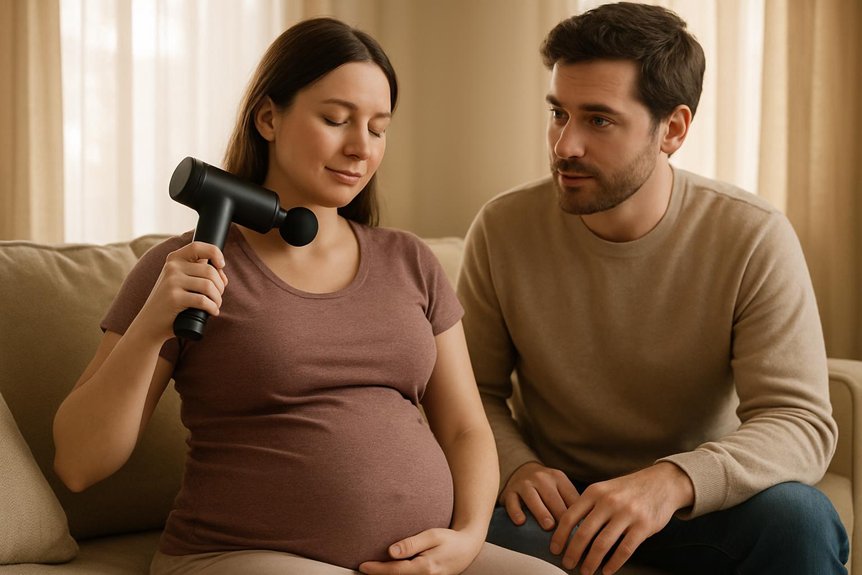
For most healthy pregnancies, gentle massage can be beneficial, but percussive massage guns introduce risks that warrant caution.
Evidence suggests high-frequency vibration and deep oscillation may provoke discomfort, bruise-prone tissues, or irritate sensitive joints and ligaments softened by relaxin.
Abdominal, lower back, pelvic, and inner-thigh regions are strictly inappropriate for percussion.
Over bony landmarks, varicosities, or areas with swelling, use is contraindicated.
From Spa & Massage’s clinical perspective, hands-on prenatal massage by trained therapists offers safer modulation of pressure, positioning, and pacing.
If a client still considers a device, medical clearance and trimester-specific adjustments are essential.
Low settings, brief durations, and avoidance of heat are prudent.
Side-lying or semi-reclined positions protect circulation.
Their therapists prioritise gentle techniques, monitored feedback, and calm breathing to maintain comfort and connection.
Many find that specialised approaches such as aromatherapy massage promote relaxation and healing without the intensity of percussive devices.
Benefits and Risks to Consider
From Spa & Massage’s clinical perspective, massage guns may offer targeted relief for myofascial tension in the back, hips, and legs. However, evidence in pregnancy remains limited and device intensity varies widely.
Safety hinges on cautious settings, avoiding the abdomen and lower back, limiting session duration, and stopping immediately if pain, numbness, cramping, or dizziness occurs.
Use should be avoided with high‑risk pregnancy, placenta previa, preeclampsia, threatened preterm labour, vaginal bleeding, reduced fetal movements, or any clinician-advised restrictions.
Potential Benefits Explained
A massage gun may offer targeted relief for common pregnancy discomforts—such as myofascial tightness, calf cramping, and upper-back tension—by promoting local circulation and reducing muscle hypertonicity. However, its use requires caution due to increased vascularity, ligament laxity, and heightened sensitivity in pregnancy.
When carefully applied to non-abdominal areas, percussive therapy can ease trigger-point irritability, support lymphatic return in heavy legs, and reduce delayed-onset muscle soreness from postural strain.
Some individuals report improved sleep quality when muscular discomfort settles, and gentler settings may help downregulate sympathetic arousal.
From Spa & Massage’s clinical perspective, these benefits overlap with outcomes achieved through skilled hands-on prenatal massage—graded pressure, controlled pacing, and breath-led relaxation.
Their therapists prioritise comfort positioning, softer amplitudes, and slow, rhythmic techniques that respect changing tissues and circulation.
Important Safety Cautions
Given pregnancy-related changes in blood flow, tissue sensitivity, and joint laxity, percussive devices should be used with strict precautions and medical clearance when indicated. Evidence suggests localised vibration can alter perfusion, provoke reflex contractions, and irritate already sensitised tissues.
Conservative parameters—lowest speed, soft head, brief sessions under five minutes per region—reduce mechanical load. Avoid direct use over the abdomen, lower back midline, pelvic girdle, and any area with varicosities, oedema, bruising, or numbness.
Stop immediately if cramping, dizziness, pelvic pressure, or unusual fetal movement occurs.
At Spa & Massage, therapists favour manual pregnancy techniques to modulate tone safely, introducing percussive tools only when a clinician approves and only on distal muscle groups (e.g., calves, forearms) with vigilant monitoring.
Hydration, slow breathing, and gentle post-session stretching are recommended.
When to Avoid Use
When should a massage gun be avoided in pregnancy? It should not be used with placenta previa, vaginal bleeding, reduced fetal movements, preeclampsia or uncontrolled hypertension, preterm labor signs, cervical insufficiency, recent abdominal pain, fever or infection, unexplained swelling, or a history of blood clots.
Avoid directly over the abdomen, lower back in the first trimester, and any bruised, varicose, numb, or inflamed areas.
Discontinue if dizziness, pain, uterine tightening, or spotting occurs.
Spa & Massage advises against use after fertility treatments, recent procedures, or if high-risk has been identified by a midwife or obstetrician.
Those with gestational diabetes, pelvic girdle pain, or sciatica should seek clinician guidance.
In our clinics, therapists prioritise gentle, manual prenatal massage and personalised positioning, reserving percussive tools for postpartum care when medically appropriate.
Areas to Avoid and Areas That May Be Safer
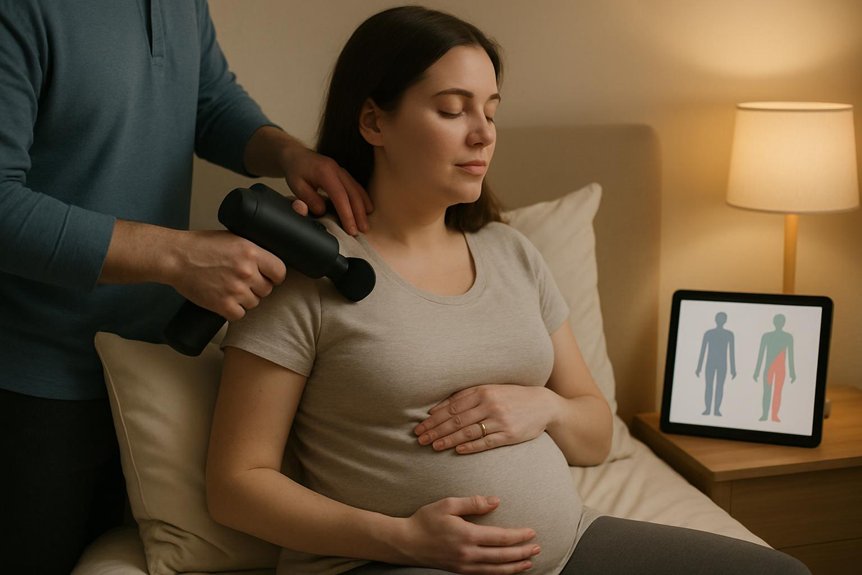
In pregnancy, high-frequency percussive devices should not be applied over the abdomen, lower back/sacrum, pelvis, or anywhere directly over the uterus due to theoretical risks of uterine stimulation, vascular compromise, and discomfort.
Avoid the groin, inner thighs, and any area with varicosities, bruising, numbness, or suspected DVT. Direct use over the spine, kidneys, or over bony prominences is also discouraged.
Areas that may be safer, if clearance has been given by a midwife or obstetrician, include the upper back and shoulders, lateral hips/gluteal muscles away from the sacrum, calves, and forearms—always avoiding sustained pressure near major vessels.
At Spa & Massage, therapists favour gentle, hands-on pregnancy techniques for these regions, adjusting positioning and support to maintain comfort, breath, and calm, while steering clear of contraindicated zones.
Pressure, Speed, and Duration Guidelines
After identifying safer regions and areas to avoid, attention turns to how a massage gun is applied: pressure, speed, and duration materially influence safety during pregnancy. Evidence supports a conservative approach.
Light, surface-level contact is advised—just enough to gently mobilise tissue without provoking tenderness or vibration deep into the abdomen, pelvis, or low back. Low speed settings reduce mechanical load and startle responses; higher speeds can amplify tissue oscillation and discomfort.
Short bouts are prudent. Spa & Massage recommends 30–60 seconds per muscle group, with a total session under 10 minutes, pausing to assess comfort and fetal awareness. Avoid lingering on any spot. If warmth, pulsing, or guarding appears, stop.
Our therapists counsel slow breathing, relaxed positioning, and hand-held self-checks to confirm pressure remains light and soothing.
Trimester-by-Trimester Considerations
Trimester-specific guidance matters:
In the first trimester, Spa & Massage advises avoiding massage guns altogether or limiting to gentle, indirect use away from the abdomen and lower back due to higher miscarriage risk and embryonic development.
As pregnancy progresses, clinicians recommend low-intensity, short sessions on non-abdominal areas only, with medical clearance if there are complications.
In late pregnancy, adjustments include avoiding the supine position, steering clear of trigger points that may stimulate uterine activity (e.g., around the ankles and sacrum), and prioritising hands-on prenatal techniques from trained therapists.
First Trimester Cautions
Why exercise extra caution with massage guns in the first trimester? Early pregnancy is a period of rapid embryonic development and higher miscarriage risk, so conservative practice is warranted.
Evidence suggests percussion devices can trigger strong neuromuscular responses; Spa & Massage advises avoiding high-intensity settings, prolonged sessions, and use over the abdomen, low back, glutes near the sacrum, inner thighs, and any acupressure points linked to uterine activity. Nausea, breast tenderness, and dizziness are common; vibration may aggravate these.
Clinically, low-amplitude, brief, peripheral use (e.g., calves, forearms) may be safer if a midwife or GP agrees. Our therapists prefer hands-on pregnancy techniques instead, using gentle strokes and neutral oils, with careful positioning.
If cramping, spotting, or unusual discomfort occurs, stop immediately and seek medical advice.
Late Pregnancy Adjustments
In late pregnancy, mechanical percussion requires stricter modulation due to increased uterine sensitivity, ligamentous laxity, fluid shifts, and a higher incidence of back, pelvic, and lower‑limb oedema.
At Spa & Massage, therapists advise avoiding the abdomen, lumbosacral area, and medial thighs, and limiting use to low-intensity, broad-head attachments for brief intervals on calves, forearms, and upper back.
Side‑lying or seated positioning reduces aortocaval compression and supports breath.
Gentle effleurage and lymphatic-paced strokes are preferred for oedema; percussion is avoided over varicosities or numb areas.
Any cramping, pelvic pressure, or reduced fetal movement warrants cessation and clinical review.
Hydration and paced breathing are encouraged.
Many clients instead book our prenatal massage, where trained therapists modulate pressure safely and individualise care.
When to Skip the Massage Gun and Seek Help
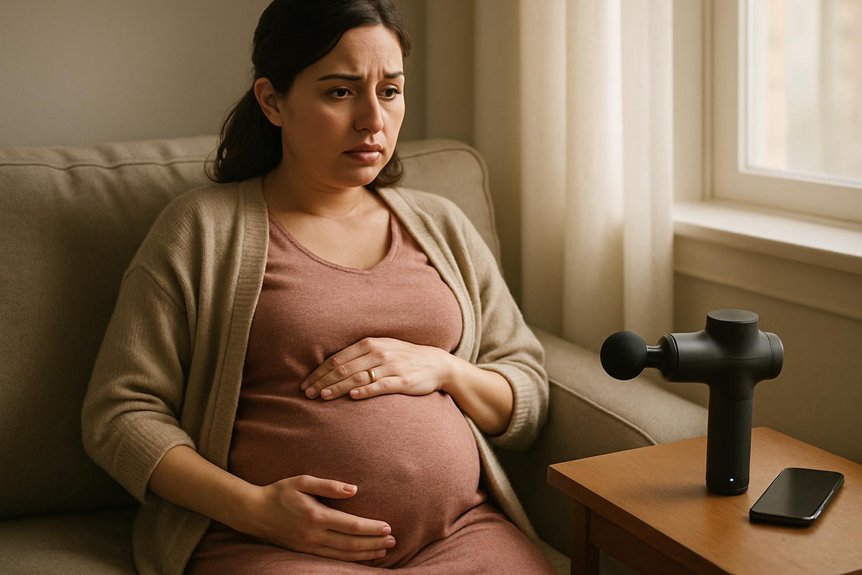
Although massage guns can relieve muscular tension, certain scenarios warrant avoidance and professional assessment.
Persistent or worsening pain, numbness, tingling, new swelling, redness, calf tenderness, shortness of breath, chest pain, dizziness, severe headaches, visual changes, reduced fetal movements, vaginal bleeding, fluid loss, fever, or signs of infection should prompt immediate medical review.
Devices should not be used over the abdomen, lower back after the first trimester, varicose veins, bruises, areas of decreased sensation, or near the pelvis if experiencing pelvic girdle pain or sciatica.
Those with placenta previa, preeclampsia, hypertension, a history of preterm labour, clotting disorders, or on anticoagulants should avoid percussive devices entirely.
At Spa & Massage, therapists advise pausing self-treatment and seeking obstetric guidance first, then opting for a clinically adapted prenatal massage plan.
Spa & Massage Therapist-Approved Alternatives
Several safer, clinician-endorsed options can replace a massage gun during pregnancy, and Spa & Massage therapists prioritise these to protect maternal and fetal wellbeing.
Their preferred modalities include side-lying prenatal massage with gentle, sustained pressure; light-to-moderate myofascial techniques for upper back and hips; and manual lymphatic drainage for swelling. Heat is kept warm, not hot, and pressure is avoided over the abdomen, sacrum, and known acupressure trigger points.
Evidence-informed self-care tools are also endorsed: a soft foam roller, seated tennis-ball release against a wall, and breath-led pelvic floor relaxation.
For soothing intimacy, our clinics use unscented or pregnancy-safe aromatherapy dilutions after screening. Short, frequent sessions (20–40 minutes) are favoured over deep, percussive work.
When symptoms escalate, therapists coordinate with midwives or GPs.
Aftercare Tips Our Therapists Recommend
Following a pregnancy-safe massage, Spa & Massage therapists advise structured aftercare to optimise benefits and minimise adverse effects.
They recommend hydrating with water or warm herbal infusions, then resting for 20–30 minutes to allow parasympathetic settling.
Gentle walking and diaphragmatic breathing reduce post‑treatment light‑headedness.
Warm (not hot) showers support circulation; clients should avoid saunas and prolonged heat exposure.
At our clinics, unscented or pregnancy-safe oils are used; if any skin sensitivity occurs, cleanse with lukewarm water and monitor for rash.
They advise side‑lying rest with cushions under bump and between knees to protect the pelvis.
Movement should be low‑intensity for 24 hours; avoid massage guns or deep pressure.
Report dizziness, contractions, vaginal bleeding, reduced fetal movements, or persistent pain promptly to a midwife.
Conclusion
In the hush of expectancy, a massage gun can be both balm and bellwether. Evidence suggests selective, gentle use may ease aches, yet contraindications loom like hidden reefs—high-risk pregnancy, abdominal or low-back application, blood clot risk, placenta concerns. Safer shores include light, short sessions on calves, glutes, and shoulders, avoiding trigger points and acupressure zones. When in doubt, professional prenatal massage is the steadier compass. Hydration, rest, and clinician guidance keep the vessel trimmed, the voyage safer.
